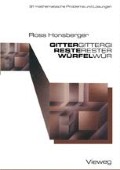Zusammenfassung
Die Zahl 3 kann auf vier Arten als Summe einer oder mehrerer natürlicher Zahlen dargestellt werden, wenn man die Anordnung der Summanden berücksichtigt:
Wie viele solcher Darstellungen gibt es für die Zahl n?
Pi Mu Epsilon, Vol. 1, 149-54, S. 186, Problem 27, gestellt von Arthur B. Brown, Queens College, gelöst von William Moser, University of Toronto.
Access this chapter
Tax calculation will be finalised at checkout
Purchases are for personal use only
Rights and permissions
Copyright information
© 1984 Friedr. Vieweg & Sohn Verlagsgesellschaft mbH, Braunschweig
About this chapter
Cite this chapter
Honsberger, R. (1984). Die geordneten Partitionen von n. In: Gitter — Reste — Würfel. Vieweg+Teubner Verlag. https://doi.org/10.1007/978-3-322-83974-9_2
Download citation
DOI: https://doi.org/10.1007/978-3-322-83974-9_2
Publisher Name: Vieweg+Teubner Verlag
Print ISBN: 978-3-528-08476-9
Online ISBN: 978-3-322-83974-9
eBook Packages: Springer Book Archive

